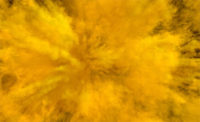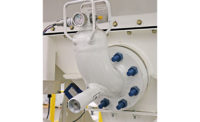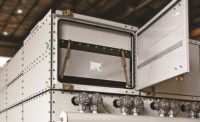Operations that produce dust as a byproduct of their processes rely on an industrial dust collection system to provide clean air to the workplace, ensure the health and safety of employees, and comply with EPA, OSHA and NFPA regulations. However, the dust collection system itself could be a source of danger if it isn’t properly equipped and maintained.
Here are six important questions to ask when evaluating the safety of your dust collection system:
1) Do we need deflagration protection?
A deflagration is a subsonic explosion (slower than the speed of sound) created by an expanding ball of flame that is rapidly consuming a cloud of dust as fuel—as opposed to a detonation, which is a propagation of flame at a velocity greater than the speed of sound. Detonations cannot be controlled or mitigated mechanically by venting in most cases.
The National Fire Protection Association (NFPA) classifies the explosibility of dusts using their KSt values ranging from zero to greater than 300. If the KSt value of your dust is greater than zero, you must provide explosion protection on your dust collector. An explosion vent opens when the pressure inside the collector reaches a predetermined level that is lower than the design pressure of the dust collector. When the vent opens, the excess pressure and flame front exit to a safe area away from buildings and populated areas.
When venting outdoors is not an option, an indoor flameless vent is installed over a standard explosion vent. A flameless vent consists of a housing that includes a panel of high-temperature mesh that absorbs heat and flame. During an event, the vent opens, releasing the pressure and fireball into the housing. The mesh layers strip the fuel particles from the deflagration, allowing only a portion of the pressure wave and smoke byproduct to pass more safely into the working environment and removing the dangerous flame ball from the equation.
2) Why is it important to know the pressure capability?
When the dust inside the collector combusts, the pressure inside the collector can reach unsafe levels. The pressure capability of your dust collector is used to properly specify and size the explosion venting. It’s important to compare venting vessel strength to the deflagration strength and vent burst pressure for effective deflagration protection.
Values to consider are the Kst (normalized rate of pressure rise) and Pmax (maximum pressure for an unvented dust explosion) values. These factors are used to determine if the burst pressure of the event would be lower than the enclosure strength. This is necessary in order to identify if the pressure of the deflagration would be relieved before it could build to levels that would destroy the collector enclosure.
3) How do we prevent a deflagration from traveling through the ductwork?
One solution is to equip the ducting with a flow-activated isolation valve to protect downstream work areas and processes from the propagation of flame and pressure through the inlet duct when deflagration occurs in a dust collector. The pressure wave will close the valve, preventing the passage of flame and smoke to areas upstream of the valve. The valve latches shut and must be manually opened.
4) How can we prevent fires?
You can add fire safety features and technologies to your system, such as flame-retardant filter media and spark arrestors, which are drop-out boxes, perforated screens or cyclone devices installed at collector inlets. Depending on your application, you might be required to install sprinkler systems.
Also, don’t store dust in the hopper of the collector. The sole purpose of the hopper is to funnel process dust to a storage bin. Dust that has accumulated in a hopper creates a potential fire or deflagration risk. Dust in the hopper may also clog the system and prevent the filter pulse-cleaning from doing its job.
5) How do we know if we are complying with emissions regulations?
Air quality testing can show if you are meeting OSHA exposure limits for the dusts produced at your facility. OSHA has established Personal Exposure Limits (PELs) based on an eight-hour time-weighted average (TWA) for hundreds of dusts. The OSHA PEL requirements determine the minimum level of filtration efficiency your dust collector must achieve.
The Minimum Efficiency Reporting Value (MERV) ratings scale provides a good indicator of a dust collector filter’s initial efficiency. However, it does not measure pressure drop, emissions while pulsing, energy performance or the other parameters that better reflect dust collector efficiency.
A way to measure your dust collector's emissions effectiveness is to test it according to ANSI/ASHRAE Standard 199-2016, Method of Testing the Performance of Industrial Pulse Cleaned Dust Collectors. The test measures four key dust collector performance parameters: emissions, pressure drop, compressed air usage and emission reading.
6) Can filter change-outs affect safety?
Keep the dust collector operating at top efficiency to maintain air quality by changing the filters when airflow through the system reaches the differential pressure limit the manufacturer recommends. For heavy dust-loading applications, you might need to replace filters more often.
When it’s time for filter replacement, your workers should not have to enter the dust collector to change them. For optimal safety, filters should be easily accessible and slide in and out of the housing readily. Fast-open heavy-gauge doors can provide access to a simple cartridge change-out system that does not require entry into the collector. Look for doors that have an exclusive lock-out feature for worker safety.






